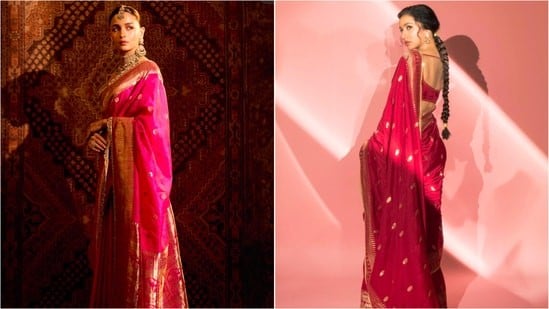

How to check a pure Banarasi silk saree? Experts share key tips to identify the real from the fake.
Sarees have always been a cornerstone of indian fashion, blending tradition with timeless elegance. While modern fashion trends continue to evolve, the charm of sarees, especially Banarasi silk, remains ever-strong.
Authentic Banarasi sarees are handwoven with exceptional silk yarn, showcasing the meticulous craftsmanship of skilled artisans.
Unfortunately, with the increasing demand for these iconic garments, the market has seen a rise in counterfeit versions, often priced steeply despite their inferior quality. To ensure you're getting the genuine article and not falling prey to scams, it's essential to know how to spot an authentic Banarasi silk saree.
Nishit Gupta, fashion expert and director at KALKI, shared some valuable tips with HT lifestyle to help you identify a pure Banarasi saree.
1. Flip to the other side
Pure Banarasi silk sarees are all handwoven and have incredible handwork, which often takes weeks, sometimes even months. Flip over the saree and check for the back view; authentic Banarasi has floating threads that are a staple for handmade weavings. Machine-made sarees have a smoother back with minimal thread work.
2. The Banarasi GI (Geographical Indication) tag
A pure Banarasi silk saree carries a GI tag, which guarantees its authenticity and origin from Varanasi, India. Always check for this certification when purchasing to ensure you're investing in a genuine handwoven saree.
3. Check the weight of the saree
Pure Banarasi silk sarees are slightly heavier because of the rich silk threads and the real zari work. If the saree feels too light yet claims to have intricate zari work, it's definitely not authentic.
4. Purity of zari
Original Banarasi sarees contain real gold and silver zari, whereas modern Banarasi sarees may use tested or imitation zari. To test, rub the zari lightly; if a reddish or silver thread is seen underneath, then it is real. If a white or plastic-like thread comes out, it is artificial.
5. Ring test
Pass the saree through a small ring; the pure silk saree should move through without resistance. Synthetic or blended sarees may gather or get stuck.
6. Price and authenticity check
Pure Banarasi silk sarees are an investment, and the price reflects the workmanship. If the price seems too low for an intricately woven saree, it is probably a synthetic or power-loom alternative.
Other tips to keep in mind
Bringing her expertise to the same fashion designer, deepika Govind highlighted the following key points to help identify a genuine Banarasi saree.
Examining the motifs is important. Banarasi sarees are usually adorned with intricate floral foliage, bel amru, ambi, and many more, often identified by their delicate Mughal motifs.
The finesse of craftsmanship and expertise is easily identifiable.
Next, verify the seller's authenticity.
Pure silk of the highest quality is used in Banarasi sarees.
Weaves like katan are unique to Banarasi sarees. Katan features a smooth weave and is heavier in grams.
Banarasi sarees also use pure silver zari and gold-plated zari.
The most important thing to remember is to check for polyester blends. To do this, pull out a thread and burn it. If it is polyester, it will melt into clumps. However, if it is pure silk, it will emit a smell resembling human hair.
"To further verify the purity of the silver zari, you can use a magnet. Another way is to rub the zari threads on a granite stone, which should leave a residue of gold or silver color. When examining the back of the saree, note that machine-made floats will be smooth. Look for pin marks made by the weaver in handloom weaves, and always ask for a certificate of authenticity," says Deepika.




 click and follow Indiaherald WhatsApp channel
click and follow Indiaherald WhatsApp channel